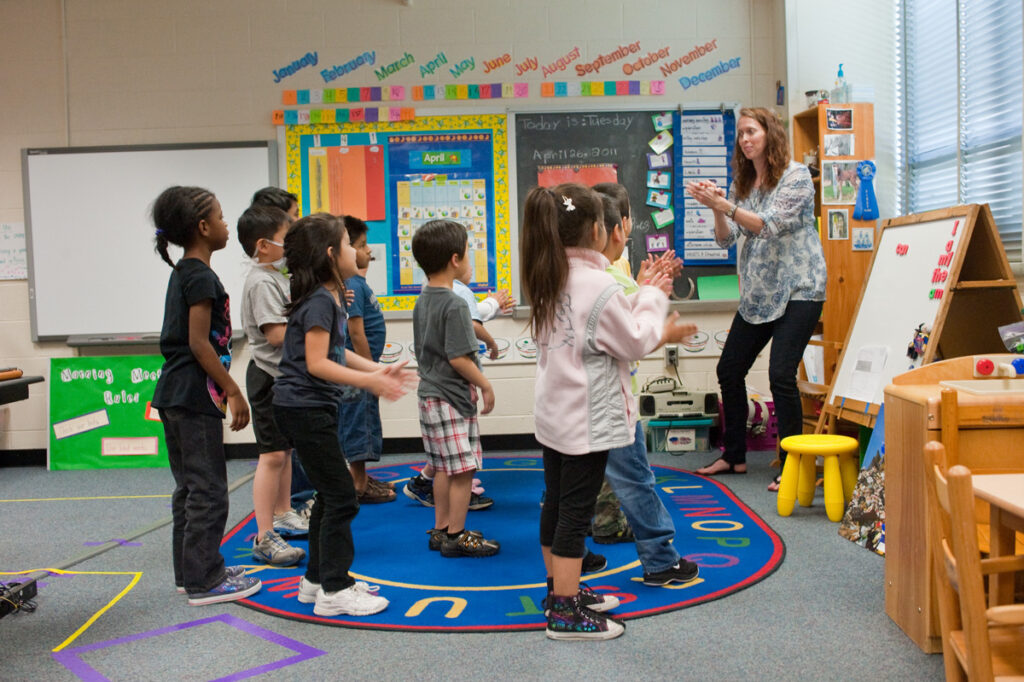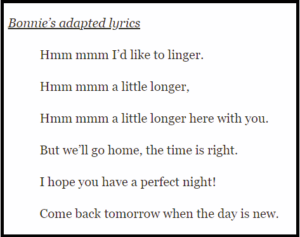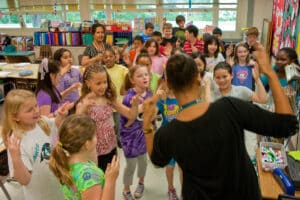
I remember singing along with friends in my elementary school days. Teachers and students began each day with singing. We learned about music from our music teacher, but we sang everywhere—in our classrooms and on the playground. One winter, you could find us out at recess, climbing the snowbanks to sing into imaginary microphones, “ I wanna hold your hand…” We were the Beatles, rocking and rolling on our stage of snow. Singing was the gateway to our imaginations. Now my grandchildren sing “Let it go…” along with Disney’s Elsa or match their vocals with The Wiggles. So it goes.
Throughout history, singing has been integrated into people’s daily lives. Mothers sang to lull their babies to sleep, students sang school songs to demonstrate pride in their school and country, and railroad laborers sang as they worked. Enslaved people in the American South sang to give each other hope and to pass along messages of empowerment. Immigrants sang songs from their homeland, preserving culture and precious memories. In celebration and ritual, singing connects people to each other and to their collective history.

In the classroom, singing together is fun and is a good way to build community. Singing favorite songs is a great Morning Meeting activity. Celebrating birthdays with a selection from a repertoire of birthday songs can become a class tradition. Teachers can begin and end the day with special songs. I know a first-grade teacher who ends every day in closing circle, singing a lovely song, a common Girl Scout tradition, with her students: “Hmmmmmm, I’d like to linger, Hmmmm a little longer, Hmmmmm I’d like to linger her with you.” (You can learn this lovely melody here, and see my adapted lyrics in the image to the right.)
Singing also offers academic benefits. If words to a song are printed on a chart, or displayed as closed captions on a music video, then singing can be a way to help build sight vocabulary, as well as phonemic awareness. Songs can help children learn different languages. Simple counting songs can reinforce math lessons. Traditional folk songs can bring history to life. Songs about rivers, stars, and rain can help children learn about the natural world and all its wonders.
Today, too many children are primarily consumers of music, not producers of it. At one time, almost every elementary classroom had a piano. Later, almost every home had MTV. Later still came popular televised singing competitions such as The Voice and American Idol where we got the clear message that singing was for the talented few—and what’s more, a competitive event. If this trend continues, something vital will be lost. But teachers have the power to bring singing back into the life of the classroom.
Don’t worry if you’re insecure about your musical ability, or even if you truly can’t carry a tune yet. You don’t need to be a singer or an experienced song leader to provide daily musical experiences that are low-pressure and that promote a feeling of success and group cohesion. Following are some suggestions for teachers who want to increase and enhance singing in their classrooms.
It’s not necessary to teach songs line by line or offer lengthy introductions. Just sing a verse in a relaxed, inviting manner and encourage children to join in when they are ready. Repeat the verse a few times, make eye contact, smile–soon the children will be singing along. However, it is important to know a song well before teaching it, unless you are using a recording to introduce it. One way for you to learn new songs is by singing along with recorded music in the car.

It will probably be fairly easy to encourage younger children to sing. But no matter how relaxed you are about introducing a song, older children may initially feel embarrassed to sing. Sometimes I use humor: “Okay, this is not a concert. I’m not Taylor Swift. This is a sing-a-long. That means you…and me…singing along! Let’s go!”
Another way to invite the participation of older children is to ask them what they like to sing. Once, working with a group of middle school students, I asked them which songs worked best for students their age. We sang a variety of songs and decided together which ones were most suitable for middle school, and which would be best for younger students.
There’s a wealth of music to choose from: folk songs, songs from different cultures, songs written by contemporary songwriters, chants, and play party songs. Older children enjoy songs that are more complex, funny, or a little irreverent. Younger ones prefer predictable, simple songs with a repetitive melody line. K-2 teachers can make up silly songs that grow from the daily routine. For example, my students enjoyed “Wanna go to recess? Clean up now. Clean up now. Clean up now!” We sang this to the tune of “I’m a Little Teapot,” but feel free to make up your own tune. The melody is up to you!
To help remember favorite songs, keep a song list posted in the classroom. Maintain a collection on Google Drive. Add to these as you and the children discover new songs. Record lyrics on chart paper or on PowerPoint slides. Create and print song sheet collections. Although you won’t necessarily teach songs from a written version, it can be helpful to have song sheets to jog memories and promote literacy development.
When choosing songs, it’s important to be aware of the historical significance of the songs and sensitive to themes that might be offensive. Some wonderful old folk songs might not work well in a contemporary context. There are also songs that seem innocuous in their current form but originally had lyrics that mocked or demeaned particular groups of people. For example, the song Jump Jim Joe has been a widely used music and movement activity in primary music classes, but it was originally the minstrel show song called Jump Jim Crow. While this song offers much in terms of musical benefits, it is rooted in racism and in its original form, promoted terribly derogatory stereotypes. I would not use the song in an elementary classroom.
A musicologist might think that preservation of such songs is an important part of a comprehensive music education. That may be true for higher education within the full historical context, but if a song is going to cause pain for any student or their families, we can find other ways to explore melody, rhythm, creativity, and musical connections. When we know better, we do better. If you’re not sure about a song, research it. Check it out with other teachers or adult community members. A great source for examining traditional music in this way is the Smithsonian Institution (see the section on further resources below for more information).
Once you have identified songs to share, you will want to become comfortable leading them. As with any new skill, practice helps. So, sing a lot. Sing in the car, in the shower, while vacuuming the floor or going for a walk. Not only will you internalize the words and melody, you will strengthen your own vocal abilities. Just like any other muscle, “use it or lose it” applies to singing!
To become more comfortable and adept at teaching songs, you can watch other song leaders, sit in on a music class, or talk with colleagues about how they lead songs. As you observe and gather information, ask yourself: “What do I like about their style? How do they engage the group? What doesn’t work? What fits my style?” Not everyone does this the same way. You’ll find what works for you.
The more you sing with children throughout the school day, the less singing will feel like a “big deal.” As you hear your students singing, you’ll hear children having fun. Instead of being a performance, singing will be simply another way you make connections within your classroom community. And remember, your enthusiasm about singing is worth a lot more than your musical expertise, so come on and sing!
Bonnie Baer-Simahk is a consulting teacher with the Center for Responsive Schools. She shared songs with children for many years in her ESL and kindergarten classrooms. Her own three children have grown up to become teachers, musicians, and musical theatre performers, sharing songs with people in their classrooms, on Broadway, and around the world!